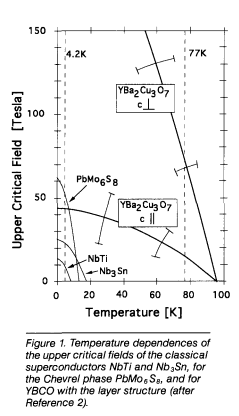Crossref Citations
This article has been cited by the following publications. This list is generated based on data provided by
Crossref.
Prosandeyev, S. A.
and
Tennenboum, I. M.
1995.
Electronic structure of the surfaces of layered copper oxides.
Physical Review B,
Vol. 52,
Issue. 6,
p.
4545.
Locquet, J.-P.
Jaccard, Y.
Cretton, A.
Williams, E. J.
Arrouy, F.
Mächler, E.
Schneider, T.
Fischer, O/.
and
Martinoli, P.
1996.
Variation of the in-plane penetration depthλabas a function of doping inLa2−xSrxCuO4±δthin films onSrTiO3: Implications for the overdoped state.
Physical Review B,
Vol. 54,
Issue. 10,
p.
7481.
Klemenz, C.
and
Scheel, H.J.
1996.
Flat YBa2Cu3O7−x layers for planar tunnel-device technology.
Physica C: Superconductivity,
Vol. 265,
Issue. 1-2,
p.
126.
Shimizu, Takashi
Nonaka, Hidehiko
and
Arai, Kazuo
1996.
Growth of homoepitaxial YBa2Cu3O7 − films by molecular beam epitaxy.
Journal of Crystal Growth,
Vol. 166,
Issue. 1-4,
p.
841.
Kawasaki, M.
Ohtomo, A.
Tsuchiya, R.
Nishino, J.
and
Koinuma, H.
1997.
Oxide Quantum Structures for Future Electro-Photonics.
MRS Proceedings,
Vol. 474,
Issue. ,
Einarsrud, Mari-Ann
Moe, Anne Marie Mardal
and
Julsrud, Stein
1997.
Growth and characterisation of YBa2Cu3O7 − x high Tc superconducting crystals.
Journal of Crystal Growth,
Vol. 182,
Issue. 3-4,
p.
363.
Utke, I.
Klemenz, C.
Scheel, H.J.
and
Nüesch, P.
1997.
High-temperature X-ray measurements of gallates and cuprates.
Journal of Crystal Growth,
Vol. 174,
Issue. 1-4,
p.
813.
Watson, Ian M.
1997.
Metal‐organic CVD of the high‐Tc superconductor YBa2Cu3O7−δ.
Chemical Vapor Deposition,
Vol. 3,
Issue. 1,
p.
9.
Chrisey, Douglas B.
1997.
Progress in the first ten years of HTS film growth.
JOM,
Vol. 49,
Issue. 10,
p.
28.
Changkang, Chen
1998.
Phase diagram and its application to the crystal growth of high Tc oxide superconductors.
Progress in Crystal Growth and Characterization of Materials,
Vol. 36,
Issue. 1-2,
p.
1.
Odier, Philippe
Gotor, Francisco J
Pellerin, Nadia
Lobo, Ricardo P.S.M
Dembinski, Kristof
Ayache, Jeanne
Noel, Henry
Potel, Michel
Chaminade, Jean Pierre
and
Collin, Gaston
1998.
Copper deficiency in YBa2Cu3O7−x ceramics, textured and single crystals.
Materials Science and Engineering: B,
Vol. 52,
Issue. 2-3,
p.
117.
Salluzzo, M.
Maggio-Aprile, I.
and
Fischer, O.
1999.
Improved structural properties and surface morphology of Nd/sub 1+x/Ba/sub 2-x/Cu/sub 3/O/sub 7-δ/ thin films deposited by d.c. magnetron sputtering.
IEEE Transactions on Appiled Superconductivity,
Vol. 9,
Issue. 2,
p.
1856.
Scotti di Uccio, U.
Lombardi, F.
and
Miletto Granozio, F.
1999.
Structural properties of single-domain (103) YBCO films grown on buffered (110) MgO.
Physica C: Superconductivity,
Vol. 323,
Issue. 1-2,
p.
51.
Tretyakov, Yuri D
and
Goodilin, Eugene A
2000.
Chemical principles of preparation of metal-oxide superconductors.
Russian Chemical Reviews,
Vol. 69,
Issue. 1,
p.
1.
Shiohara, Yuh
and
Goodilin, Eugene A.
2000.
High-Temperature Superconductors - I.
Vol. 30,
Issue. ,
p.
67.
Scheel, Hans J
2000.
Historical aspects of crystal growth technology.
Journal of Crystal Growth,
Vol. 211,
Issue. 1-4,
p.
1.
Tanaka, Isao
Ashizawa, Ken
Tanabe, Hideyoshi
Watauchi, Satoshi
and
Yamanaka, Junji
2001.
Preparation of La2−xSrxCuO4 single-crystalline films by infrared-heated liquid phase epitaxial technique.
Physica C: Superconductivity,
Vol. 362,
Issue. 1-4,
p.
180.
Salluzzo, M.
Andreone, A.
Cassinese, A.
Di Capua, R.
Iavarone, M.
Maglione, M.G.
Pica, G.
and
Vaglio, R.
2001.
Superconducting properties of YNdBaCuO and NdBaCuO thin films deposited by dc sputtering.
IEEE Transactions on Appiled Superconductivity,
Vol. 11,
Issue. 1,
p.
3201.
Yamada, Yasuji
and
Hirabayashi, Izumi
2001.
Liquid phase epitaxy of YBa2Cu3O7−x film: exploration of new seed layer materials and additives in the solvent.
Journal of Crystal Growth,
Vol. 229,
Issue. 1-4,
p.
343.
Salluzzo, M.
Aruta, C.
Maggio-Aprile, I.
Fischer, �.
Bals, S.
and
Zegenhagen, J.
2001.
Growth of R1+xBa2-xCu3O7-? Epitaxial Films Investigated by In Situ Scanning Tunneling Microscopy.
physica status solidi (a),
Vol. 186,
Issue. 3,
p.
339.
